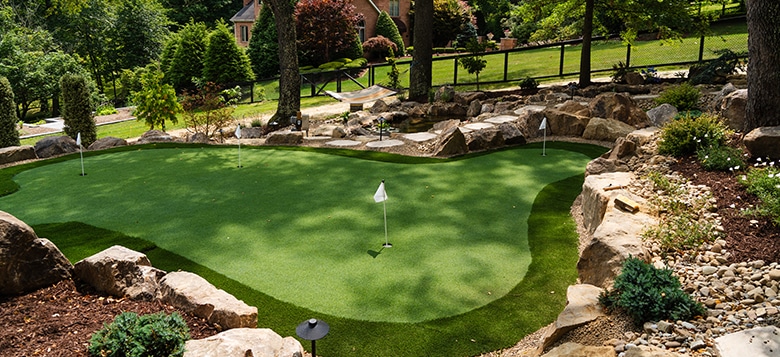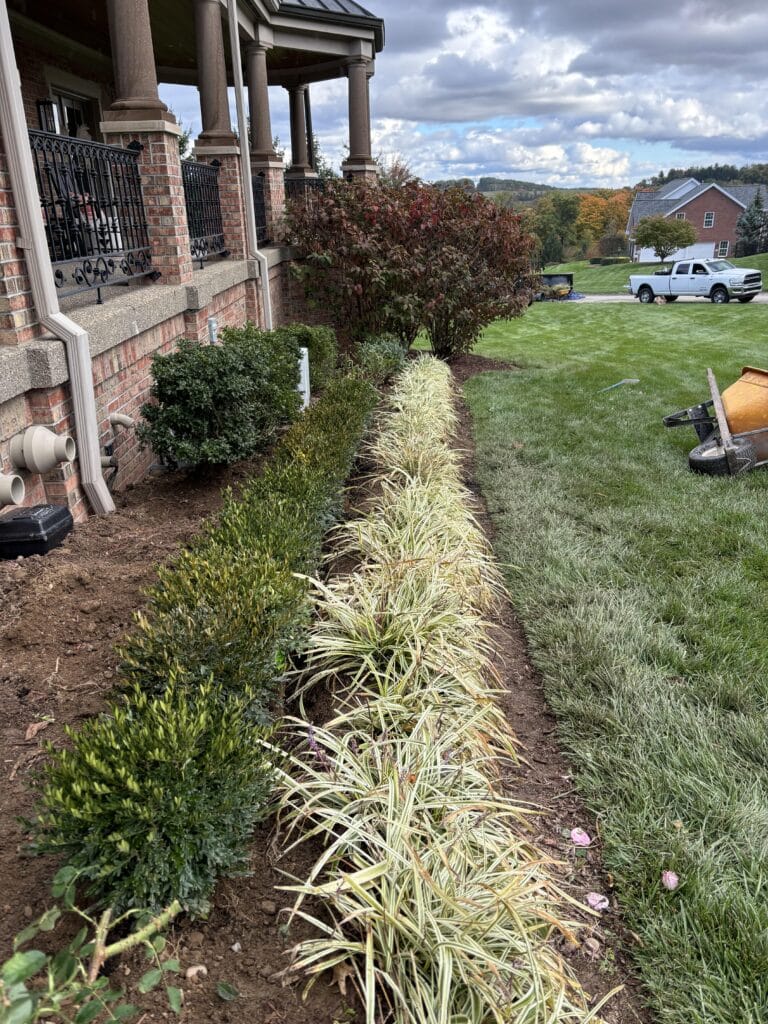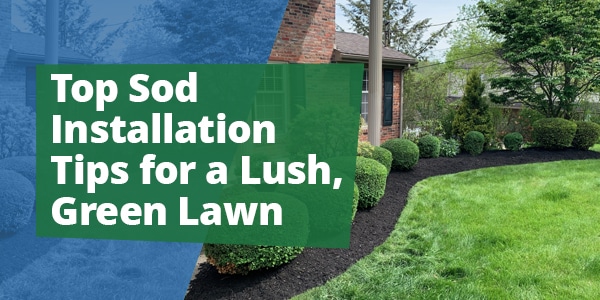Sod installation is the fastest way to achieve a lush, green lawn. This article will guide you through the step-by-step process, from preparing your soil to laying the sod and maintaining it for long-lasting beauty.
Key Takeaways
- Proper soil preparation, including removing existing vegetation and conducting soil tests, is essential for successful sod installation and a healthy lawn.
- Choosing the right sod variety, such as Kentucky Bluegrass or Tall Fescue, tailored for Pittsburgh’s climate is crucial for long-term lawn vitality.
- Post-installation care, including a consistent watering schedule, proper mowing, and limiting foot traffic, is vital for establishing strong roots and a robust lawn.
Preparing Your Soil for Sod Installation
Proper soil preparation is the cornerstone of successful sod installation. Many sod installation failures stem from poor soil preparation, leading to issues like inadequate rooting and weed growth. Removing debris and creating a level area through proper soil preparation can significantly enhance grass growth. Proper soil preparation sets the stage for a lush, green lawn that will thrive for years to come.
The first steps in preparing your soil surface involve removing existing vegetation, loosening the soil, and conducting necessary soil tests and amendments. Each of these steps plays a vital role in ensuring that your sod has the best possible environment to establish roots and grow into a healthy lawn.
Let’s dive into the details of each step to ensure your soil is perfectly prepped for sod installation.
Removing Existing Grass
Before you can lay sod, it’s essential to remove any existing grass and weeds. This step is crucial for the successful installation of new sod, as remnants of old grass can hinder root establishment and growth. Using tools like a sod cutter can simplify this process. A sod cutter efficiently cuts through the old grass and roots, making it easier to lift and remove the unwanted vegetation.
Starting with a clean slate gives your new sod the best chance to thrive in a healthy, weed-free environment.
Loosening the Soil
Once the old grass is removed, the next step is to loosen the soil. Tilling the soil to a depth of 6-8 inches improves air flow and water drainage, which are critical for root penetration and overall plant health. This process helps create a better soil structure, allowing the roots of your new sod to grow deeply and establish a strong foundation.
Properly aerated soil encourages robust grass growth and a healthy lawn.
Soil Testing and Amendments
Conducting a soil test before installing sod can provide valuable insights into nutrient deficiencies and pH imbalances that need correction. Soil testing helps determine if amendments like lime or sulfur are needed to create optimal conditions for grass growth. Skipping this step can hinder the sod’s ability to establish roots, leading to a weakened lawn.
Addressing deficiencies identified in soil test results ensures that your soil is nutrient-rich for a thriving, lush lawn.

Choosing the Right Sod for Pittsburgh Yards
Selecting the right sod variety is crucial for a healthy lawn, especially considering Pittsburgh’s unique climate. Cool-season grasses are preferred for Pittsburgh due to their adaptability to the region’s cold winters and warm summers. Choosing a sod that can thrive under these conditions will ensure your lawn remains vibrant and robust throughout the year.
Next, we’ll explore the best sod varieties for Pittsburgh and where to purchase quality sod. Understanding these options will help you make an informed decision that suits your lawn’s specific needs, ensuring a lush and resilient turf.
Best Sod Varieties for Pittsburgh
For Pittsburgh yards, Kentucky Bluegrass, Tall Fescue, and Fine Fescue are excellent choices. Kentucky Bluegrass is highly adaptable and thrives in northern Pennsylvania. Tall Fescue is low-maintenance and tolerates drought conditions well, making it a reliable option for busy homeowners. Fine Fescue is suitable for shady areas and requires minimal upkeep.
Each of these varieties offers unique benefits suited to Pittsburgh’s climate, ensuring your lawn remains healthy and attractive.
Where to Buy Quality Sod
When it comes to purchasing sod, a local sod farm is a reliable source for high-quality products. These farms grow sod that matches the climatic and soil conditions of the region, ensuring a better fit for your lawn.
Choosing a reputable local supplier like Cascades Landscaping ensures quality and compatibility, setting the foundation for a beautiful and resilient lawn.
The Step-by-Step Process of Laying Sod
The Quick Steps for Laying Sod
- Accurate Measurement: Measure your lawn’s length and width to determine the precise amount of sod needed, minimizing waste.
- Proper Installation: Lay sod the same day it’s delivered; align pieces tightly without overlapping for seamless coverage.
- Rolling and Watering: Roll sod to eliminate air pockets and ensure soil contact; water consistently for the first 7-10 days to promote rooting.
- Professional Assistance: Consider hiring sod installation services for expert handling and optimal results.
Why Hire Cascades Landscaping for Sod Installation
Hiring a professional like Cascades Landscaping for your sod installation offers numerous benefits:
- Expertise and Experience: Professionals have the knowledge and experience to handle the installation process efficiently, ensuring a healthy and vibrant lawn.
- Time-Saving: Sod installation can be labor-intensive and time-consuming. Hiring professionals frees up your time for other activities while ensuring the job is done quickly and correctly.
- Proper Equipment: Professionals have access to specialized tools and equipment necessary for precise sod laying, rolling, and watering.
- Quality Assurance: With a reputable company like Cascades Landscaping, you can expect high-quality sod and a guarantee of satisfaction with the installation process.
- Post-Installation Care: Professionals offer guidance on post-installation care, ensuring your newly installed sod lawn establishes successfully and thrives.
- Additional Services: Cascades Landscaping can provide additional services like irrigation system installation, enhancing the efficiency and health of your lawn.
Choosing Cascades Landscaping ensures a seamless, stress-free sod installation experience, resulting in a beautiful and healthy lawn.
Post-Installation Care for New Sod
Proper care after sod installation is crucial for establishing a healthy lawn. Keeping the sod moist during installation prevents wilting and supports root establishment. Adding 1 to 2 inches of sand can reduce soil compaction and improve moisture retention for the new sod. Additionally, maintaining an ideal sandy soil pH of around 6.5 with amendments like sulfur or lime can further enhance the health of your turf. Following these post-installation care guidelines ensures that your new sod lawn will thrive and grow into a beautiful, lush landscape while considering the sod installation cost.
Let’s delve into the specific post-installation care practices, including the initial watering schedule, mowing and fertilizing, and limiting foot traffic, to provide your new sod with the best possible start.
Initial Watering Schedule
After sod installation, it’s essential to irrigate until the soil is moist to help establish roots. Light watering after the sod is installed helps settle it in place. Water newly laid sod twice daily, ideally in the morning and afternoon, during the first week. Apply approximately 2 inches of water daily in multiple sessions during the first week.
After the first week, reduce watering to about 1 inch per day and adjust based on weather conditions. Failing to maintain a consistent watering schedule can result in sod that either dries out or becomes waterlogged, leading to poor root establishment and overall lawn health.
Mowing and Fertilizing New Sod
Mowing can begin about one week after installation when the grass appears to need cutting, ensuring it is well-rooted before starting. Using a walk-behind mower set to a high cutting height is recommended for mowing new sod.
Fertilization for newly laid sod should be done every 30 days to promote robust growth. Leaving grass clippings on the lawn can also contribute nutrients back to the soil, promoting a healthier lawn.
Limiting Foot Traffic
Minimizing foot traffic is crucial for the first week to help new sod roots establish without disruption. Avoid walking on the new sod as much as possible to prevent soil compaction and root damage.Low disruption during the establishment period of new sod ensures that the grass can root deeply and grow into a healthy, robust lawn.

Common Sod Installation Mistakes to Avoid
Even with the best intentions, common mistakes during sod installation can hinder the establishment of a healthy lawn. Overlapping sod pieces can lead to an uneven and bumpy lawn surface. Ensuring that sod pieces are laid side by side without gaps is essential for even coverage and a smooth lawn.
Another common mistake is laying new turf on top of old grass, which can prevent proper sod establishment. Additionally, delaying sod installation after purchase can lead to poor establishment or increased soil death. By following proper steps during sod installation, such as avoiding overlaps and ensuring timely installation, you can avoid these issues and promote successful turfgrass establishment.
Let’s take a closer look at two specific mistakes to avoid: overlapping sod pieces and inconsistent watering, to ensure your sod installation is a success.
Overlapping Sod Pieces
Overlapping sod pieces can lead to weak grass growth due to uneven root establishment. Overlapping sections can create voids and ultimately disrupt the overall appearance of the lawn.
To avoid overlap, ensure that sod pieces are cut to fit snugly together, creating tight butt joints. Proper installation techniques reinforce that sod must be laid in a staggered pattern to minimize overlaps.
Inconsistent Watering
Following a consistent watering schedule during the first two weeks is crucial for the establishment of new sod. Initial watering should be frequent to promote root establishment but should be adjusted based on weather conditions. Ensuring the sod remains adequately hydrated fosters strong root growth and prevents patchy growth and poor lawn health.
Maintaining a regular watering routine helps new sod thrive and develop into a lush, green lawn.
Enhancing Your Lawn with Additional Services
Beyond the basics of sod installation, additional services can significantly enhance the functionality and appearance of your lawn. Integrating services like irrigation systems and landscape lighting can sustainably improve the health and beauty of your outdoor space. Cascades Landscaping provides supplementary services, including irrigation setup, to enhance the overall health of your lawn. These enhancements not only improve the lawn’s aesthetics but also increase its usability and value.
In the subsections that follow, we’ll explore the benefits of installing an irrigation system and incorporating landscape lighting to make your lawn the envy of the neighborhood.
Installing an Irrigation System
A well-designed sprinkler system ensures even watering, leading to a healthier and more vibrant lawn. An irrigation system minimizes water waste by providing targeted watering, which is crucial for maintaining sod in dry climates.
Automating the watering process with an irrigation system ensures lawns receive consistent moisture without the inefficiencies of manual watering. Watering at night with an irrigation system minimizes evaporation, conserving water and reducing overall utility costs.
Cascades Landscaping offers professional irrigation system setup to enhance the efficiency of your lawn care.
Landscape Lighting for Added Appeal
Proper landscape lighting can transform outdoor spaces, increasing both aesthetic appeal and functionality during evening hours. Incorporating landscape lighting can extend outdoor living hours, creating an inviting space for relaxation and entertainment after dark.
Well-placed outdoor lighting enhances the visual appeal of landscaping features, increasing property value and curb appeal. Landscape lighting showcases your lawn and other elements, enhancing outdoor spaces by improving visibility and creating a beautiful, welcoming environment.
Summary
Achieving a lush, green lawn involves several crucial steps, from thorough soil preparation to selecting the right sod and following precise installation and care practices. Proper soil preparation, including removing existing vegetation, loosening the soil, and conducting soil tests, sets the stage for healthy grass growth. Choosing sod varieties suited to Pittsburgh’s climate and purchasing quality sod from local farms ensures your lawn thrives year-round. Following a detailed step-by-step process for laying sod and providing diligent post-installation care, including consistent watering and limiting foot traffic, promotes robust root establishment. Avoiding common mistakes and considering additional services like irrigation systems and landscape lighting can further enhance the health and beauty of your lawn. By implementing these tips, you can create a vibrant, healthy lawn that will be the pride of your neighborhood.

